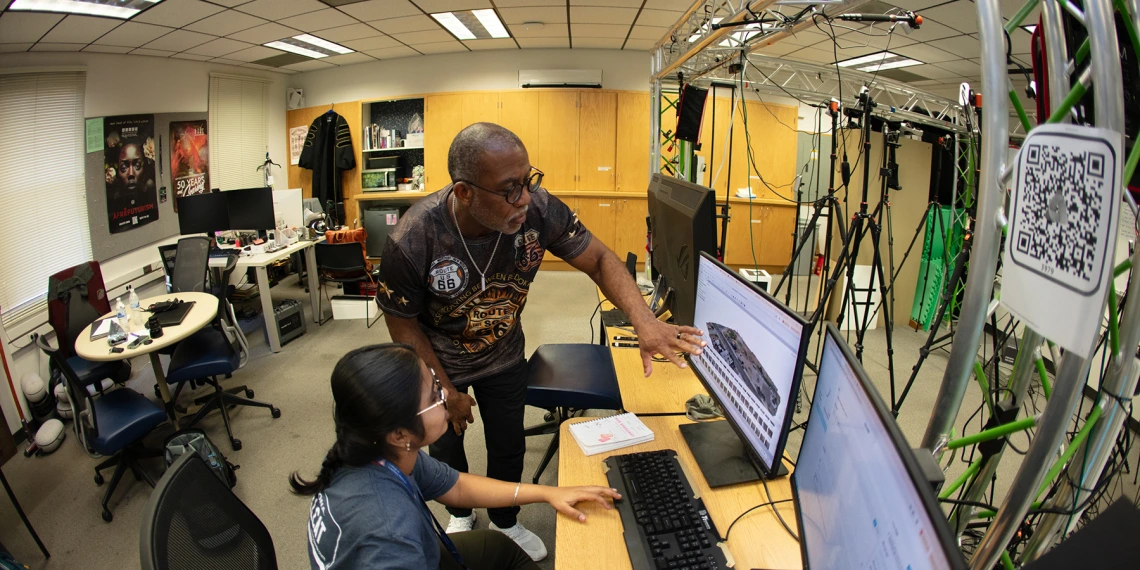$3M award from the U.S. Department of Commerce brings digital access to Southern Arizona neighborhoods

Center for Digital Humanities Director Bryan Carter talks with Rajitha Reddy Tiruthani as she works on a 3D model.
Leslie Hawthorne Klingler
Tucson, AZ—On the fourth floor of the Modern Languages building, Center for Digital Humanities Director Bryan Carter laughs into the phone as he coordinates a meeting with a local school principal. Nearby, two of his students from Arizona’s Science, Engineering, and Math Scholars (ASEMS) Program are hard at work: Tristan Britt is programming a Temi robot for classroom use, and Rajitha Reddy Tiruthani is constructing a 3D model for the National Trust for Historic Preservation.
For the past two years, Carter has dedicated much of his time to an outward-focused transdisciplinary endeavor: Project CAN (Connect Arizona Now: Digital Inclusion for Underserved Students and Communities of Southern Arizona). The $3 million initiative was funded through a U.S. Department of Commerce pilot program open to Minority Serving Institutions; the U of A was eligible to apply as a Hispanic Serving Institution (HSI). Riley McIsaac, director of HSI grants development at the UA, identified the opportunity and managed the proposal writing process.
“I love how this project expands perceptions of what HSI-related funding can accomplish, and I look forward to seeing it progress. The benefits to Southern Arizona communities can’t be overstated.” — Riley McIsaac, director of HSI grants development
“Working with Bryan on this grant was extremely rewarding,” McIsaac said. “I love how this project expands perceptions of what HSI-related funding can accomplish, and I look forward to seeing it progress. The benefits to Southern Arizona communities can’t be overstated.”
“Broadband is a basic utility, not a luxury,” Carter says. Without it, education, jobs, healthcare, and connection are nearly impossible, he says. He warns that leaving communities behind as technology advances is a grave risk to local, state, and national ambitions.
Over the course of the two-year grant period (currently in extension through December 2025), Carter and a team of 18 developers from multiple colleges worked with five communities: two near U of A’s main campus in central Tucson—Dunbar and Pascua Yaqui—and three near U of A micro campuses in Yuma, Douglas, and Thatcher.
At Dunbar Pavilion—on the former site of Tucson’s only segregated school—Project CAN enabled the community center to upgrade its broadband and install a computer lab with VR headsets, a volumetric capture stage, a 3D printer, and an industrial printer. Carter’s team then worked with Dunbar leaders and residents to design digital programming to meet community priorities. Today, the lab hosts free AARP computer training for seniors, youth tech programs, and workshops for entrepreneurs.
At the Pascua Yaqui microcampus, Project CAN is supporting the installation of a volumetric capture stage to preserve elders’ stories in holographic 3D. The project is also funding youth digital programs developed in collaboration with the tribe.
“You have to be willing to show up and listen, and then show up and listen again,” he says.
For Carter, the key to success is starting with community needs, not pre-set plans. “You have to be willing to show up and listen, and then show up and listen again,” he says. Africana Studies’ long-standing collaboration with Dunbar made the center a natural partner, but even with that trust, patience and flexibility were essential. The team and community leaders navigated a slow funding rollout, historic-building restrictions, leadership transitions, and utility installation delays. When youth participation waned outside the summer months, they shifted focus to supporting small businesses.
The effort has been more than worth it, says Carter. “Attendance at community events has surged. Seniors in the neighborhood are gaining digital skills. New financial literacy programs are reaching broader audiences. When you see all that, you just wish you could extend it to more communities.” Several pilot projects at local churches and community centers now await funding to continue.
Carter is convinced the world will be a better place when we learn to center the human in technology development.
Carter is convinced the world will be a better place when we learn to center the human in technology development. He finds deep satisfaction in seeing students take this approach into their own work.
Reddy Tiruthani says her work on Project CAN has inspired her to use her skills to improve education. “I want to make tools that help students build confidence and prepare for jobs in today’s world. I want them to get excited about learning, even if they’ve struggled in traditional settings.” She gestures to the 161-million–data-point 3D image she’s building of the historic Osterman filling station on Route 66. “I hope it makes people curious about Arizona in the 1930s, and maybe even excited to learn more about history.”

